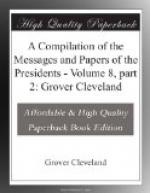Although this demarcation involves a double deviation from the proclamation of 1763 (first, in following a river instead of highlands; second, in taking a small branch instead of pursuing the main supply of the Bay of Chaleurs), the northwest angle of Nova Scotia may be considered as at last fixed by British authority at a point many miles north of the point claimed to be such in the statements laid before the King of the Netherlands on the part of Great Britain, and 48 miles to the north of where the line of “abraded highlands” of Messrs. Featherstonhaugh and Mudge crosses the St. John. Were it not that the American claim would be weakened by any change in the strong ground on which it has always rested, it might be granted that this is in fact the long-lost northwest angle of Nova Scotia, and the highlands allowed to be traced from that point through the sources of the branches of the St. John and the St. Lawrence.
In proof of the position now assigned to this angle of New Brunswick, and consequently of ancient Nova Scotia, in the absence of documents which the archives of Great Britain alone can furnish, the map published by the Society for the Encouragement of Useful Knowledge, the several maps of the surveyor-general of the Province of Canada, and the most recent map of the Provinces of Nova Scotia and New Brunswick, by John Wyld, geographer to the Queen of Great Britain, may be cited.
It may therefore be concluded that the northwest angle of Nova Scotia is no longer an unknown point. It can be found by a search conducted in compliance with the proclamation of 1763 and the contemporaneous commission of Governor Wilmot, and the researches of the present commission show that it can not be far distant from the point originally assigned to it in the exploring meridian line. The identity of the first of these documents with the boundary of the treaty of 1783 is admitted, and the latter is word for word the same with the description of the eastern boundary of the United States in the same treaty. Moreover, a northwest angle has been assigned to the Province of New Brunswick by British authority, which, did it involve no dereliction of principle, might without sensible loss be accepted on the part of the United States.
IV.—HIGHLANDS OF THE TREATY OF 1783.
The highlands of the treaty of 1783 are described as those “which divide those rivers that empty themselves into the river St. Lawrence from those which fall into the Atlantic Ocean.” It has been uniformly and consistently maintained on the part of the United States that by the term “highlands” was intended what is in another form of the same words called the height of land. The line of highlands in this sense was to be sought by following the rivers described in the treaty to their source and drawing lines between these sources in such manner as to divide the surface waters. It was believed that the




